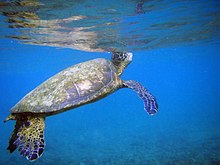Sea turtle
| Sea turtles | |
|---|---|
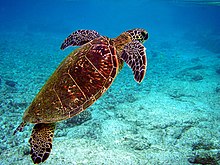
| |
| A green sea turtle, a species of the sea turtle superfamily | |
| Scientific classification | |
| Domain: | Eukaryota |
| Kingdom: | Animalia |
| Phylum: | Chordata |
| Class: | Reptilia |
| Order: | Testudines |
| Suborder: | Cryptodira |
| Clade: | Americhelydia |
| Clade: | Panchelonioidea |
| Superfamily: | Chelonioidea Bauer, 1893[2] |
| Families | |
| |
| Synonyms[2] | |
|
Chelonii - Oppel, 1811
| |
Sea turtles (superfamily Chelonioidea), sometimes called marine turtles,
Sea turtles can be categorized as hard-shelled (cheloniid) or leathery-shelled (dermochelyid).[8] The only dermochelyid species of sea turtle is the leatherback.[8]
Description
For each of the seven species of sea turtles, females and males are the same size. As adults, it is possible to tell male turtles from female turtles by their long tails with a cloacal opening near the tip. Adult female sea turtles have shorter tails, with a cloacal opening near the base. Hatchling and sub-adult turtles do not exhibit sexual dimorphism; it is not possible to determine their sex by looking at them.[9]
In general, sea turtles have a more fusiform body plan than their terrestrial or freshwater counterparts. This tapering at both ends reduces volume and means that sea turtles cannot retract their head and limbs into their shells for protection, unlike many other turtles and tortoises.[10] However, the streamlined body plan reduces friction and drag in the water and allows sea turtles to swim more easily and swiftly.
The leatherback sea turtle is the largest sea turtle, reaching 1.4 to more than 1.8 m (4.6 to 5.9 ft) in length and weighing between 300 and 640 kg (661 to 1,411 lbs).[11] Other sea turtle species are smaller, ranging from as little as 60 cm (2 ft) long in the case of the Kemp's ridley, which is the smallest sea turtle species, to 120 cm (3.9 ft) long in the case of the green turtle, the second largest.[5][12]
The skulls of sea turtles have cheek regions that are enclosed in bone.[13][14] Although this condition appears to resemble that found in the earliest known fossil reptiles (anapsids), it is possible it is a more recently evolved trait in sea turtles, placing them outside the anapsids.[15][13]
Taxonomy and evolution
Sea turtles, along with other turtles and tortoises, are part of the order Testudines. All species except the leatherback sea turtle are in the family Cheloniidae. The superfamily name Chelonioidea and family name Cheloniidae are based on the Ancient Greek word for tortoise: χελώνη (khelone).[16] The leatherback sea turtle is the only extant member of the family Dermochelyidae.
Fossil evidence of marine turtles goes back to the
The oldest possible representative of the lineage (
Sea turtles' limbs and brains have evolved to adapt to their diets. Their limbs originally evolved for locomotion, but more recently evolved to aid them in feeding. They use their limbs to hold, swipe, and forage their food. This helps them eat more efficiently.[27][28]
Cladogram
Below is a cladogram showing the phylogenetic relationships of living and extinct sea turtles in the Chelonioidea based on Evers et al. (2019):[29]
|
An alternate phylogeny was proposed by Castillo-Visa et al. (2022):[26]
| Panchelonioidea |
| |||||||||||||||||||||||||||||||||||||||||||||||||||||||||||||||||||||||||||||||||
Distribution and habitat
Sea turtles can be found in all oceans except for the polar regions. The flatback sea turtle is found solely on the northern coast of Australia. The Kemp's ridley sea turtle is found solely in the Gulf of Mexico and along the East Coast of the United States.[30]
Sea turtles are generally found in the waters over continental shelves. During the first three to five years of life, sea turtles spend most of their time in the pelagic zone floating in seaweed mats. Green sea turtles in particular are often found in Sargassum mats, in which they find food, shelter and water.[31] Once the sea turtle has reached adulthood it moves closer to the shore.[32] Females will come ashore to lay their eggs on sandy beaches during the nesting season.[33]
Sea turtles migrate to reach their spawning beaches, which are limited in numbers. Living in the ocean therefore means they usually migrate over large distances. All sea turtles have large body sizes, which is helpful for moving large distances. Large body sizes also offer good protection against the large predators (notably sharks) found in the ocean.[34]
In 2020, diminished human activity resulting from the COVID-19 virus caused an increase in sea turtle nesting. Some areas in Thailand saw an abnormally high number of nests, and Florida experienced a similar phenomenon. Less plastic and light pollution could explain these observations.[35]
Life cycle
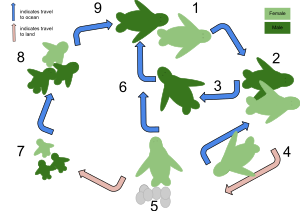
Sea turtles are thought to reach sexual maturity from about 10−20 years old depending on species and methodology. However, reliable estimates are difficult to ascertain.[36][37][38][39] Mature sea turtles may migrate thousands of miles to reach breeding sites. After mating at sea, adult female sea turtles return to land to lay their eggs. Different species of sea turtles exhibit various levels of philopatry. In the extreme case, females return to the same beach where they hatched. This can take place every two to four years in maturity.

The mature nesting female hauls herself onto the beach, nearly always at night, and finds suitable sand in which to create a nest. Using her hind flippers, she digs a circular hole 40 to 50 centimetres (16 to 20 in) deep. After the hole is dug, the female then starts filling the nest with her clutch of soft-shelled eggs. Depending on the species, a typical clutch may contain 50–350 eggs. After laying, she re-fills the nest with sand, re-sculpting and smoothing the surface, and then camouflaging the nest with vegetation until it is relatively undetectable visually.[31] She may also dig decoy nests.[40] The whole process takes 30 to 60 minutes. She then returns to the ocean, leaving the eggs untended.[41]
Females may lay 1–8 clutches in a single season. Female sea turtles alternate between mating in the water and laying their eggs on land. Most sea turtle species nest individually. But ridley sea turtles come ashore en masse, known as an arribada (arrival). With the Kemp's ridley sea turtle this occurs during the day.
Sea turtles have temperature-dependent sex determination, meaning the developing baby sea turtle's sex depends on the temperature it is exposed to.[42][43][44][45][46] Warmer temperatures produce female hatchlings, while cooler temperatures produce male hatchlings.[42][43][44][45][46][47] The eggs will incubate for 50–60 days. The eggs in one nest hatch together over a short period of time. The baby sea turtles break free of the egg shell, dig through the sand, and crawl into the sea. Most species of sea turtles hatch at night. However, the Kemp's ridley sea turtle commonly hatches during the day. Sea turtle nests that hatch during the day are more vulnerable to predators, and may encounter more human activity on the beach.
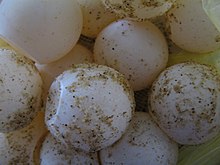
Larger hatchlings have a higher probability of survival than smaller individuals, which can be explained by the fact that larger offspring are faster and thus less exposed to predation. Predators can only functionally intake so much; larger individuals are not targeted as often. A study conducted on this topic shows that body size is positively correlated with speed, so larger baby sea turtles are exposed to predators for a shorter amount of time.
In 1987, Carr discovered that the young of green and loggerhead sea turtles spent a great deal of their
Physiology
Osmoregulation
Sea turtles maintain an internal environment that is
Leatherback sea turtles face an increased osmotic challenge compared to other species of sea turtle, since their primary prey are jellyfish and other gelatinous plankton, whose fluids have the same concentration of salts as sea water. The much larger lachrymal gland found in leatherback sea turtles may have evolved to cope with the higher intake of salts from their prey. A constant output of concentrated salty tears may be required to balance the input of salts from regular feeding, even considering leatherback sea turtle tears can have a salt ion concentration almost twice that of other species of sea turtle.[53]
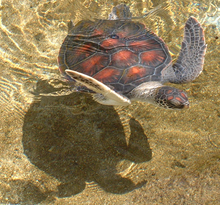
Hatchlings depend on drinking sea water immediately upon entering the ocean to replenish water lost during the hatching process. Salt gland functioning begins quickly after hatching, so that the young sea turtles can establish ion and water balance soon after entering the ocean. Survival and physiological performance hinge on immediate and efficient hydration following emergence from the nest.[51]
Thermoregulation
All sea turtles are poikilotherms.[54] However, leatherback sea turtles (family Dermochelyidae) are able to maintain a body temperature 8 °C (14 °F) warmer than the ambient water by thermoregulation through the trait of gigantothermy.[54][55]
Green sea turtles in the relatively cooler Pacific are known to haul themselves out of the water on remote islands to bask in the sun. Sea turtles are air-breathing reptiles that have lungs, so they regularly surface to breathe. Sea turtles spend a majority of their time underwater, so they must be able to hold their breath for long periods.[57] Dive duration largely depends on activity. A foraging sea turtle may typically spend 5–40 minutes underwater[57] while a sleeping sea turtle can remain underwater for 4–7 hours.[58][59] Remarkably, sea turtle respiration remains aerobic for the vast majority of voluntary dive time.[57][59] When a sea turtle is forcibly submerged (e.g. entangled in a trawl net) its diving endurance is substantially reduced, so it is more susceptible to drowning.[57]
When surfacing to breathe, a sea turtle can quickly refill its lungs with a single explosive exhalation and rapid inhalation. Their large lungs permit rapid exchange of oxygen and avoid trapping gases during deep dives.
Cold-stunning is a phenomenon that occurs when sea turtles enter cold ocean water (7–10 °C (45–50 °F)), which causes the turtles to float to the surface and therefore makes it impossible for them to swim.[60]
Gruber and Sparks (2015) According to Gruber and Sparks (2015), Diving physiology
Fluorescence
The two
Sensory modalities
Below the surface, the sensory cues available for navigation change dramatically.[65] Light availability decreases quickly with depth, and is refracted by the movement of water when present, celestial cues are often obscured, and ocean currents cause continuous drift.[65] Most sea turtle species migrate over significant distances to nesting or foraging grounds, some even crossing entire ocean basins.[66] Passive drifting within major current systems, such as those in the North Atlantic Gyre, can result in ejection well outside of the temperature tolerance range of a given species, causing heat stress, hypothermia, or death.[66] In order to reliably navigate within strong gyre currents in the open ocean, migrating sea turtles possess both a bicoordinate magnetic map and magnetic compass sense, using a form of navigation termed Magnetoreception.[66][65][67] Specific migratory routes have been shown to vary between individuals, making the possession of both a magnetic map and compass sense advantageous for sea turtles.[66]

A bicoordinate magnetic map gives sea turtles the ability to determine their position relative to a goal with both latitudinal and longitudinal information, and requires the detection and interpretation of more than one magnetic parameter going in opposite directions to generate, such as
Natal homing behavior is well described in sea turtles, and genetic testing of turtle populations at different nesting sites has shown that magnetic field is a more reliable indicator of genetic similarity than physical distance between sites.[70] Additionally, nesting sites have been recorded to "drift" along with isoline shifts in the magnetic field.[71] Magnetoreception is thought to be the primary navigation tool used by nesting sea turtles in returning to natal beaches.[70][71] There are three major theories explaining natal site learning: inherited magnetic information, socially facilitated migration, and geomagnetic imprinting.[67] Some support has been found for geomagnetic imprinting, including successful experiments transplanting populations of sea turtles by relocating them prior to hatching, but the exact mechanism is still not known.[67]
Ecology
Diet
The loggerhead, Kemp's ridley, olive ridley, and hawksbill sea turtles are omnivorous their entire life. Omnivorous turtles may eat a wide variety of plant and animal life including decapods, seagrasses, seaweed, sponges, mollusks, cnidarians, Echinoderms, worms and fish.[72][73][74][75] However, some species specialize on certain prey.
The diet of green sea turtles changes with age.[76] Juveniles are omnivorous, but as they mature they become exclusively herbivorous.[73][76] This diet shift has an effect on the green sea turtle's morphology.[77][78] Green sea turtles have a serrated jaw that is used to eat sea grass and algae.[79]
Leatherback sea turtles feed almost exclusively on jellyfish and help control jellyfish populations.[80][81]
Hawksbill sea turtles principally eat sponges, which constitute 70–95 % of their diets in the Caribbean.[82]
Larynx mechanisms
There was little information regarding the sea turtle's larynx. Sea turtles, like other turtle species, lack an epiglottis to cover the larynx entrance. Key findings from an experiment reveal the following in regards to the larynx morphology: a close apposition between the linguolaryngeal cleft's smooth mucosal walls and the laryngeal folds, a dorsal part of the glottis, the glottal mucosa attached to the arytenoid cartilage, and the way the hyoid sling is arranged and the relationship between the compressor laryngis muscle and cricoid cartilage. The glottal opening and closing mechanisms have been examined. During the opening stage, two abductor artytenoideae muscles swing arytenoid cartilages and the glottis walls. As a result, the glottis profile is transformed from a slit to a triangle. In the closing stage, the tongue is drawn posteriorly due to the close apposition of the glottis walls and linguolaryngeal cleft walls and hyoglossal sling contractions.[83]
Relationship with humans
Sea turtles are caught worldwide, although it is illegal to hunt most species in many countries.
To a much lesser extent, some species are targeted for their shells.
The
Beach towns, such as Tortuguero, Costa Rica, have transitioned from a tourism industry that made profits from selling sea turtle meat and shells to an ecotourism-based economy. Tortuguero is considered to be the founding location of sea turtle conservation. In the 1960s the cultural demand for sea turtle meat, shells, and eggs was quickly killing the once-abundant sea turtle populations that nested on the beach. The Caribbean Conservation Corporation began working with villagers to promote ecotourism as a permanent substitute to sea turtle hunting. Sea turtle nesting grounds became sustainable. Tourists love to come and visit the nesting grounds, although it causes a lot of stress to the sea turtles because all of the eggs can get damaged or harmed.[96] Since the creation of a sea turtle ecotourism-based economy, Tortugero annually houses thousands of tourists who visit the protected 35-kilometre (22 mi) beach that hosts sea turtle walks and nesting grounds.[97][98] Walks to observe the nesting sea turtles require a certified guide and this controls and minimises disturbance of the beaches. It also gives the locals a financial interest in conservation and the guides now defend the sea turtles from threats such as poaching; efforts in Costa Rica's Pacific Coast are facilitated by a nonprofit organization, Sea Turtles Forever.[99] Thousands of people are involved in sea turtle walks, and substantial revenues accrue from the fees paid for the privilege.[100]
In other parts of the world where sea turtle breeding sites are threatened by human activity, volunteers often patrol beaches as a part of conservation activities, which may include relocating sea turtle eggs to hatcheries, or assisting hatching sea turtles in reaching the ocean.[101] Locations in which such efforts exist include the east coast of India,[102] São Tomé and Príncipe,[103] Sham Wan in Hong Kong,[104] and the coast of Florida.[105]
Importance to ecosystems
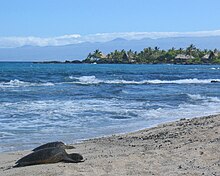
Sea turtles play key roles in two habitat types: oceans and beaches/dunes.
In the oceans, sea turtles, especially green sea turtles, are among the very few creatures (manatees are another) that eat
Sea turtles use beaches and
Sea turtles also maintain a symbiotic relationship with yellow tang, in which the fish will eat algae growing on the shell of a sea turtle.[108]
Conservation status and threats
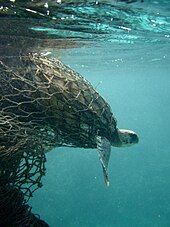
The
| IUCN Red List | United States ESA* | |
|---|---|---|
| Green | Endangered[115] | Endangered: populations in Florida and Pacific coast of Mexico populations
Threatened: all other populations[116] |
| Loggerhead | Vulnerable[117] | Endangered: NE Atlantic, Mediterranean, N Indian, N Pacific, S Pacific populations
Threatened: NW Atlantic, S Atlantic, SE Indo-Pacific, SW Indian populations[118] |
| Kemp's ridley | Critically endangered[119] | Endangered: all populations[120] |
| Olive ridley | Vulnerable[121] | Endangered: Pacific Coast of Mexico population
Threatened: all other populations[122] |
| Hawksbill | Critically endangered[123] | Endangered: all populations[124] |
Flatback
|
Data deficient[125] | N/A |
| Leatherback | Vulnerable[126] | Endangered: all populations[127] |
*The ESA manages sea turtles by population and not by species.
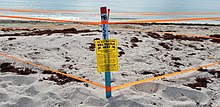
Management
In the Caribbean, researchers are having some success in assisting a comeback.[128] In September 2007, Corpus Christi, Texas, wildlife officials found 128 Kemp's ridley sea turtle nests on Texas beaches, a record number, including 81 on North Padre Island (Padre Island National Seashore) and four on Mustang Island. Wildlife officials released 10,594 Kemp's ridley sea turtle hatchlings along the Texas coast in recent years.
The
Evaluating the progress of conservation programs is difficult, because many sea turtle populations have not been assessed adequately.[130] Most information on sea turtle populations comes from counting nests on beaches, but this does not provide an accurate picture of the whole sea turtle population.[131] A 2010 United States National Research Council report concluded that more detailed information on sea turtles' life cycles, such as birth rates and mortality, is needed.[132]
Nest relocation may not be a useful conservation technique for sea turtles. In one study on the freshwater Arrau turtle (
Predators and disease
Most sea turtle mortality happens early in life. Sea turtles usually lay around 100 eggs at a time, but on average only one of the eggs from the nest will survive to adulthood.[135] Raccoons, foxes, and seabirds may raid nests or hatchlings may be eaten within minutes of hatching as they make their initial run for the ocean.[136] Once in the water, they are susceptible to seabirds, large fish and even other sea turtles.
Adult sea turtles have few predators. Large aquatic carnivores such as sharks and crocodiles are their biggest threats; however, reports of terrestrial predators attacking nesting females are not uncommon. Jaguars have been reported to smash into sea turtle shells with their paws, and scoop out the flesh.[137]
Fibropapillomatosis disease causes tumors in sea turtles.
While many of the things that endanger sea turtles are natural predators,[136] increasingly many threats to the sea turtle species have arrived with the ever-growing presence of humans.[138]
Bycatch
Sea turtles must surface to breathe. Caught in a fisherman's net, they are unable to surface and thus drown. In early 2007, almost a thousand sea turtles were killed inadvertently in the Bay of Bengal over the course of a few months after netting.[142]
However, some relatively inexpensive changes to fishing techniques, such as slightly larger hooks and traps from which sea turtles can escape, can dramatically cut the mortality rate.[143][144] Turtle excluder devices (TEDs) have reduced sea turtle bycatch in shrimp nets by 97 percent.
Beach development
Light pollution from beach development is a threat to baby sea turtles; the glow from city sources can cause them to head into traffic instead of the ocean.[145][146] There has been some movement to protect these areas. On the east coast of Florida, parts of the beach known to harbor sea turtle nests are protected by fences.[146] Conservationists have monitored hatchings, relocating lost baby sea turtles to the beach.[145]
Hatchlings find their way to the ocean by crawling towards the brightest horizon and can become disoriented along the coastline.[147] Lighting restrictions can prevent lights from shining on the beach and confusing hatchlings. Sea turtle-safe lighting uses red or amber LED light, invisible to sea turtles, in place of white light.[148]
Poaching
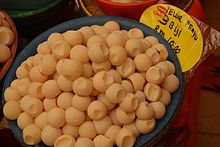
Another major threat to sea turtles is the black-market trade in eggs and meat. This is a problem throughout the world, but especially a concern in China, the Philippines, India, Indonesia and the coastal nations of Latin America. Estimates reach as high as 35,000 sea turtles killed a year in Mexico and the same number in Nicaragua. Conservationists in Mexico and the United States have launched "Don't Eat Sea Turtle" campaigns in order to reduce this trade in sea turtle products. These campaigns have involved figures such as Dorismar, Los Tigres del Norte and Maná. Sea turtles are often consumed during the Catholic season of Lent, even though they are reptiles, not fish. Consequently, conservation organizations have written letters to the Pope asking that he declare sea turtles meat.[149]
Marine debris
Another danger to sea turtles comes from marine debris, especially plastics[150] which may be mistaken for jellyfish, and abandoned fishing nets in which they can become entangled.
Sea turtles in all types are being endangered by the way humans use plastic. Recycling is known of and people recycle but not everyone does. The amount of plastic in the oceans and beaches is growing every day. The littering[151] of plastic is 80% of the amount.
When turtles hatch from their eggs on the beach, they are already endangered with plastic. Turtles have to find the ocean by themselves and on their journey from land to sea, they encounter a lot of plastic. Some even get trapped in the plastic and die from lack of resources and from the sun being too hot.
Sea turtles eat plastic bags[152] because they confuse them with their actual diet, jellyfish, algae and other components. The consumption of plastic is different for every breed of sea turtle, but when they ingest the plastic, it can clog their intestines and cause internal bleeding which will eventually kill them.
In 2015, an olive ridley sea turtle was found with a plastic drinking straw lodged inside its nose.[153] The video of Nathan J. Robinson has helped raise considerable awareness about the threat posed by plastic pollution to sea turtles.
The research into turtle consumption of plastic is growing. A laboratory of Exeter[154] and Plymouth Marine tested 102 turtles and found plastic in every one of their stomachs. The researchers found more than 800 pieces of plastic in those 102 turtles. That was 20 times more than what was found in the last research. Those researchers stated that the most common things found were cigarette buds, tire, plastic in many forms and fishing material.
The chemicals in the plastic that sea life eats damages their internal organs and can also clog their airway. The chemicals in the plastic that they eat is also a leading cause of the death of the turtles. If the turtles are close to laying eggs, the chemicals that they ingested from the plastic can seep into their eggs and affect their offspring. It is unlikely for the baby sea turtles to survive with those chemicals in their system.
There is a large quantity of plastic in the ocean, 80% of which comes from landfills; the ratio of plankton to plastic in the ocean is one to six. The "Great Pacific Garbage Patch" is a swirl of garbage in the Pacific Ocean that is 6 m (20 ft) deep and contains 3.5 million tons of garbage. This is also known as the "plastic island".
Climate change
Climate change may also cause a threat to sea turtles. Since sand temperature at nesting beaches defines the sex of a sea turtle while developing in the egg, there is concern that rising temperatures may produce too many females.[155] However, more research is needed to understand how climate change might affect sea turtle gender distribution and what other possible threats it may pose.[156]
Studies have shown that climate[157] change in the world is making sea turtles gender change. The study that was in January 2018 Current Biology "Environmental Warning and Feminization of One of the Largest Sea Turtle Populations in the World", showed how baby sea turtles were being born female a lot more than being born male. Scientists took blood samples from many baby sea turtles near the Great Barrier Reef. Prior to this study, the ratio of male to female was pretty normal. There was a little more female than there was male but it was enough to keep reproduction and life cycle normal. The study showed that there was 99% more female sea turtles then male.
The temperature[158] of the sand has a big impact on the sex of the sea turtle. This is not common with other animals but it is with sea turtles. Warmer or hot sand usually makes the sea turtle female and the cooler the sand usually makes male. Climate change has made the temperatures much hotter than they should be. The temperature of the sand gets hotter every time it is time for sea turtles to lay their eggs. With that, adaption to the sand should occur but it would take generations for them to adapt to that one temperature. It would be hard because the temperature of the sand is always changing.
The sand temperature is not the only thing that impacts sea turtles. The rise of the sea levels messes with their memory. They have an imprinted map in their memory that shows where they usually give birth and go after they do. With the rise in water levels, that map is getting messed up and is hard for them to get back to where they started. It is also taking away their beaches that they lay their eggs on. Climate change also has an impact on the number of storms and the severity of them. Storms can wipe out the sea turtles nesting ground and take out the eggs that already laid. The rising level of water is also a way for the nesting grounds to disappear. Sea turtles maps and their nesting grounds getting destroyed is harmful to them. That is because with their maps being messed up and not being able to lay eggs where they usually do makes it hard for them to find a new place to nest. They usually stick to a schedule and the messing up of a schedule messes them up.
The temperature of the ocean is also rising. This impacts their diet and what they can eat. Coral reefs are majorly impacted by the rising temperatures and a lot of sea turtles diet is coral reefs or in the coral reef. Most animals that live in coral reefs need the reefs to survive. With the reefs dying, the sea life around it also does, impacting many animals.
Oil spills
Sea turtles are very vulnerable to oil pollution, both because of the oil's tendency to linger on the water's surface, and because oil can affect them at every stage of their life cycle.[159] Oil can poison the sea turtles upon entering their digestive system.
Sea turtles[160] have a cycle that they follow from birth. The cycle depends on the sex of the turtle but they follow it all the way through life. They start by hatching on the beach, they reach the water then move out to find food. They then start their breeding migration and then mate with another turtle. For females, they make their way to the beach to start it all over again. With males, they go back to feeding after mating and doing that over again. Oil spills can affect this cycle majorly. If the female was to go and lay eggs and ingest oil, the chemicals from the oil can get passed on to the offspring and will be hard for them to survive. The diet of the sea turtles can also be impacted by oil. If the things that they eat has oil on it or has ingested oil, it can get into their system and start attacking the insides of the turtle.
Rehabilitation
Injured sea turtles are rescued and rehabilitated (and, if possible, released back to the ocean) by professional organizations, such as the Gumbo Limbo Nature Center in Boca Raton, Florida, the Karen Beasley Sea Turtle Rescue and Rehabilitation Center in Surf City, North Carolina, and Sea Turtles 911 in Hainan, China.
One rescued sea turtle, named Nickel for the coin that was found lodged in her throat, lives at the Shedd Aquarium in Chicago.
Symbiosis with barnacles
Sea turtles are believed to have a
A favorite settlement for barnacle larvae is the shell or skin around the neck of sea turtles. The larvae glue themselves to the chosen spot, a thin layer of flesh is wrapped around them and a shell is secreted. Many species of barnacles can settle on any substrate; however, some species of barnacles have an obligatory commensal relationship with specific animals, which makes finding a suitable location harder.[163] Around 29 species of "turtle barnacles" have been recorded. However, it is not solely on sea turtles that barnacles can be found; other organisms also serve as a barnacle's settlements. These organisms include mollusks, whales, decapod crustaceans, manatees and several other groups related to these species.[164]
Sea turtle shells are an ideal habitat for adult barnacles for three reasons. Sea turtles tend to live long lives, greater than 70 years, so barnacles do not have to worry about host death. However, mortality in sea turtle barnacles is often driven by their host shedding the scutes on which the barnacle is attached, rather than the death of the sea turtle itself.
This relationship, however, is not truly commensal. While the barnacles are not directly parasitic to their hosts, they have negative effects to the sea turtles on which they choose to reside. The barnacles add extra weight and drag to the sea turtle, increasing the energy it needs for swimming and affecting its ability to capture prey, with the effect increasing with the quantity of barnacles affixed to its back.[citation needed]
See also
- Cultural depictions of turtles
- Kélonia—sea turtle observatory in Réunion
- Memorandum of Understanding concerning Conservation Measures for Marine Turtles of the Atlantic Coast of Africa
- Memorandum of Understanding on the Conservation and Management of Marine Turtles and their Habitats of the Indian Ocean and South-East Asia
- Sandwatch
- Sea Turtle Association of Japan, Kuroshima Research Station
- Sea Turtle Conservancy
- Sea turtle migration
- Sea Turtles 911
- Shrimp-Turtle Case
- Threats to sea turtles
- Use of sea turtles in West African traditional medicine
References
- .
- ^ a b Rhodin, Anders G.J.; van Dijk, Peter Paul; Inverson, John B.; Shaffer, H. Bradley; Roger, Bour (2011-12-31). "Turtles of the world, 2011 update: Annotated checklist of taxonomy, synonymy, distribution and conservation status" (PDF). Chelonian Research Monographs. 5. Archived from the original (PDF) on 2012-01-31.
- ISBN 978-0412055812.
- ^ a b Fisheries, NOAA. "Sea Turtles :: NOAA Fisheries". www.nmfs.noaa.gov. Retrieved 2015-12-20.
- ^ a b "Sea Turtle Species". The State of the World's Sea Turtles. Retrieved 30 October 2023.
- ^ ISBN 978-0-309-15255-6.[page needed]
- ^ "The Flatback: Australia's Own Sea Turtle". The State of the World's Sea Turtles. 2023-10-30. Retrieved 30 October 2023.
- ^ a b Wyneken, J. 2001. The Anatomy of Sea Turtles. U.S Department of Commerce NOAA Technical Memorandum NMFS-SEFSC-470, 1-172 pp.
- ^ "How to Tell if a Sea Turtle is Male or Female". The State of the World's Sea Turtles. 2023-10-23. Retrieved 30 October 2023.
- ^ "Sea Turtles". Defenders of Wildlife. 2012-03-20. Retrieved 15 October 2015.
- ^ "Leatherback Turtle". The State of the World's Sea Turtles. 2023-10-30. Retrieved 30 October 2023.
- ^ "Sea Turtle Species". turtlehospital. Retrieved 29 August 2015.
- ^ PMID 23144831.
- .
- PMID 9826682.
- Perseus Project
- S2CID 55919209.
- ^ Kischlat, E.-E & Campos, D. de 1990. Some osteological aspects of Araripemys barretoi Price, 1973 (Chelonii, Pleurodira, Araripemydidae). In Atas do I Simpósio sobre a Bacia do Araripe e Bacias Interiores do Nordeste Crato, 14 a 16 de junho de 1990, pp. 387–395.
- PMID 26157628.
- ^ "Meet the Turtles | SWOT". www.seaturtlestatus.org. Retrieved 2017-09-20.
- ^ "An Introduction to Sea Turtles" (PDF). SWOT.
- PMID 17148342.
- S2CID 239029388. Retrieved 2022-11-17.
- ^ Chatterji, Ray (2021). The Evolution of Sea Turtles (Thesis thesis).
- ^ Goulart, Isabella Vasconcellos (2021-01-13). "Evaluation of Panchelonioidea (Testudines: Cryptodira) evolution based on phylogenetic morphometrics". Locus.
- ^ S2CID 253584457.
- ^ "Sea Turtles Use Flippers to Manipulate Food". Newswise.com. Retrieved 2018-09-16.
- ^ "Sea turtles use flippers to manipulate food".
- PMID 31106054.
- ^ "Ancient mariners threatened with extinction" (PDF).
- ^ JSTOR 2385827.
- ^ a b Brynner, Jeanna (19 September 2007). "Sea Turtles' Mystery Hideout Revealed". LiveScience. Imaginova Corp. Retrieved 20 September 2007.
- ^ "WWF – Marine Turtles". Species Factsheets. World Wide Fund for Nature. 4 May 2007. Retrieved 13 September 2007.
- PMID 21270022.
- ^ By Jack Guy; Carly Walsh (20 April 2020). "Sea turtles thriving in Thailand after beach closures". CNN. Retrieved 2020-04-20.
- PMID 36766296.
- S2CID 86092201.
- S2CID 228861161.
- .
- ^ Waldstein, David (19 May 2020). "Mother Sea Turtles Might Be Sneakier Than They Look". The New York Times. Retrieved 19 May 2020.
- ISBN 978-0-486-25144-8.
- ^ .
- ^ PMID 7079758.
- ^ S2CID 43726465.
- ^ JSTOR 1565626.
- ^ .
- JSTOR 1444765.
- .
- PMID 17878144.
- .
- ^ PMID 12077161.
- S2CID 4290812.
- JSTOR 1444922.
- ^ hdl:1834/30782.
- S2CID 4321764.
- ^ a b Green, Derek (March 1997). "Basking in Galapagos Green Turtles" (PDF). Proceedings of the 17th Annual Sea Turtle Symposium.
- ^ .
- ^ "Information About Sea Turtles: Frequently Asked Questions". Sea Turtle Conservancy. Retrieved 2015-10-15.
- ^ PMID 17148134.
- ISBN 978-0801880070
- ^ S2CID 86196418.
- ^ Lewis, Danny (2015). "Scientists just found a sea turtle that glows". Smithsonian. Retrieved 2017-03-19.
- ^ Lee, Jane J. (2015-09-28). "Exclusive video: first "glowing" sea turtle found". National Geographic News. Archived from the original on September 30, 2015. Retrieved 2017-03-19.
- ^ Hanson, Hilary (2015-09-29). "Scientists discover 'glowing' sea turtle". Huffington Post. Retrieved 2017-03-19.
- ^ PMID 18490387.
- ^ S2CID 1128978.
- ^ PMID 30728225.
- ^ PMID 21753042.
- S2CID 44529493.
- ^ PMID 29657117.
- ^ PMID 25601546.
- ISBN 978-0-7307-5549-4.
- ^ a b Bolten, A.B. (2003). "Loggerhead Turtle (Caretta caretta)". NOAA Fisheries. Archived from the original on May 14, 2010. Retrieved January 31, 2010.
- ^ Barbour, Roger, Ernst, Carl, & Jeffrey Lovich. (1994). Turtles of the United States and Canada. Washington, DC: Smithsonian Institution Press.
- ISBN 978-0-8018-9121-2. Retrieved May 27, 2010.
- ^ . Retrieved Dec 20, 2015.
- ^ "Wildlife Guide". National Wildlife Federation.
- S2CID 86312033.
- ^ "Diet & Eating Habits". seaworld.org. Retrieved 2016-04-27.
- ^ "WWF – Leatherback turtle". Marine Turtles. World Wide Fund for Nature (WWF). 16 February 2007. Retrieved 9 September 2007.
- ^ "Species Fact Sheet: Leatherback Sea Turtle". Caribbean Conservation Corporation & Sea Turtle Survival League. Caribbean Conservation Corporation. 29 December 2005. Archived from the original on 28 September 2007. Retrieved 6 September 2007.
- S2CID 22971831.
- PMID 21112993.
- ^ CITES (14 June 2006). "Appendices". Convention on International Trade in Endangered Species of Wild Flora and Fauna. Archived from the original (SHTML) on 3 February 2007. Retrieved 5 February 2007.
- UNEP-WCMC. "Eretmochelys imbricata A-301.003.003.001". UNEP-WCMC Species Database: CITES-Listed Species. United Nations Environment Programme – World Conservation Monitoring Centre. Archived from the originalon September 29, 2007. Retrieved 5 February 2007.
- OCLC 642290114.
- JSTOR 595986.
- ^ "MTN 68:8-13 Status of Nesting Populations of Sea Turtles in Thailand and Their Conservation". Seaturtle.org.
- JSTOR 2387111.
- ^ Strieker, Gary (10 April 2001). "Tortoiseshell ban threatens Japanese tradition". CNN.com/sci-tech. Cable News Network. Archived from the original on 11 March 2007. Retrieved 2 March 2007.
- S2CID 161133205.
- JSTOR 43882966.
- Thames and Hudson, 1997.
- ISBN 0-261-10265-6)
- ISBN 978-0007557271
- ^ "Sea Turtles and Humans – Sea Turtle Facts and Information". www.seaturtle-world.com. Retrieved 2017-04-24.
- ^ "Sea turtles in Tortuguero Costa Rica, a turtle haven !". Tortuguero Costa Rica Tours.
- ^ Alden, John R. (25 October 1998). "Turtle Watch in Costa Rica". The New York Times.
- Eugene Register-Guard. March 26, 2005. Retrieved November 26, 2018.
- Caribbean Conservation Corporation and the Ministry of Environment and Energy of Costa Rica. pp. 11, 21–23, 29, 32. Archived from the original(PDF) on 27 November 2018. Retrieved 30 November 2018.
- New Indian Express. Newindianexpress.com. Archived from the originalon August 10, 2013. Retrieved 2 October 2018.
- ^ Baskaran, S. Theodore (19 May 2002), "The ebb and flow of life", The Hindu, archived from the original on 16 May 2003
- ISBN 9781841624860
- ^ "Actors and activists fight for endangered green sea turtles' nesting site in Hong Kong", South China Morning Post, 26 June 2018
- ISBN 9780982694008
- ^ a b Why Care About Sea Turtles?, Sea Turtle Conservancy.
- S2CID 7194642. Retrieved October 20, 2020.
- ^ Catellacci, Alima; Wooddell, Alexandra; Rice, Marc R. "CLEANING SYMBIOSIS AND DIEL BEHAVIOR OF GREEN TURTLES (CHELONIA MYDAS) AT PUAKO, HAWAII" (PDF). Sea Turtle Research Program. USA: Hawaii Preparatory Academy. Archived from the original (PDF) on 2015-10-07. Retrieved 2019-03-23.
- ^ a b c "The IUCN Red List of Threatened Species". www.iucnredlist.org. Retrieved 2015-12-24.
- ^ "Checklist of CITES species". checklist.cites.org. Retrieved 2015-12-24.
- .
- PMID 21253007.
- ^ ISSN 0171-8630.
- ^ a b "Endangered Species Program". United States Fish & Wildlife Service. Retrieved April 12, 2012.
- . Retrieved 12 November 2021.
- ^ Fisheries, NOAA. "Green Turtle (Chelonia mydas) :: NOAA Fisheries". www.nmfs.noaa.gov. Retrieved 2015-12-24.
- . Retrieved 12 November 2021.
- ^ Fisheries, NOAA. "Loggerhead Turtle (Caretta caretta) :: NOAA Fisheries". www.nmfs.noaa.gov. Retrieved 2015-12-24.
- . Retrieved 12 November 2021.
- ^ Fisheries, NOAA. "Kemp's Ridley Turtle (Lepidochelys kempii) :: NOAA Fisheries". www.nmfs.noaa.gov. Retrieved 2015-12-24.
- . Retrieved 12 November 2021.
- ^ Fisheries, NOAA. "Olive Ridley Turtle (Lepidochelys olivacea) :: NOAA Fisheries". www.nmfs.noaa.gov. Retrieved 2015-12-24.
- . Retrieved 12 November 2021.
- ^ Fisheries, NOAA. "Hawksbill Turtle (Eretmochelys imbricata) :: NOAA Fisheries". www.nmfs.noaa.gov. Retrieved 2015-12-24.
- . Retrieved 12 November 2021.
- . Retrieved 12 November 2021.
- ^ Fisheries, NOAA. "Leatherback Turtle (Dermochelys coriacea) :: NOAA Fisheries". www.nmfs.noaa.gov. Retrieved 2015-12-24.
- ^ Clarren, Rebecca (2008). "Night Life". Nature Conservancy. 58 (4): 32–43.
- ^ Adraneda, Katherine (12 September 2007). "WWF urges RP to pursue case vs turtle poachers". Headlines. The Philippine Star. Archived from the original on 16 February 2013. Retrieved 12 September 2007.
- S2CID 33994573.
- PMID 19323172.
- ^ The National Research Council (2010). "Assessment of Sea Turtle Status and Trends: Integrating Demography and Abundance". Washington, DC: National Academies Press.
- ^ S2CID 86007443.
- S2CID 85697630.
- ^ Wright, Sara. "Hilton Head Island sees record sea turtle nesting season." Bluffton Today (2010): n. pag. Web. 8 Dec 2010.
- ^ a b "Natural." Sea Turtle Foundation. Sea Turtle Foundation, 2010. Web. 8 Dec 2010.
- ^ Baker, Natural History and Behavior, pp. 8–16
- .
- ^ Moniz, Jesse (3 February 2007). "Turtle conservation: It's now very much a political issue". News. The Royal Gazette Ltd.[permanent dead link]
- ^ Scales, Helen (27 April 2007). "Glow Sticks May Lure Sea Turtles to Death". News. National Geographic News. Archived from the original on April 30, 2007.
- ^ NYSDEC. "Atlantic Hawksbill Sea Turtle Fact Sheet". Endangered Species Unit. Retrieved 7 February 2007.
- ^ "Fishermen blamed for turtle deaths in Bay of Bengal". Science News. Reuters. 5 February 2007. Archived from the original on 15 November 2016. Retrieved 15 November 2016.
- ^ "MTN 113:13-14 Longline Fishery Panel Discussion at the 26th Annual Sea Turtle Symposium: Cooperative Approaches to Implement Sea Turtle Bycatch Solutions in Longline Fisheries". www.seaturtle.org.
- ^ O'Kelly-Lynch, Ruth. "Govt: Long-line fishing won't hurt birds".[permanent dead link]
- ^ Panama City News Herald.
- ^ a b "The Milky Way". Hijos de las Estrellas. Season 1. Episode 8. 2014. 37, 43 minutes in. Netflix.
- ^ Witherington, Blair E. "Understanding, Assessing, and Resolving Light Pollution Problems on Sea Turtle Nesting Beaches" (PDF). paed.org.ph. Retrieved 2021-02-05.
- ^ "Information About Sea Turtles: Threats from Artificial Lighting – Sea Turtle Conservancy". Retrieved 2021-02-05.
- ISSN 0458-3035. Retrieved 2015-12-22.
- ^ "Ocean Plastic". SEE Turtles. Retrieved 2019-11-20.
- ^ "Ocean Plastic". SEE Turtles. Retrieved 2019-12-12.
- ^ "What do sea turtles eat? Unfortunately, plastic bags". World Wildlife Fund. Retrieved 2019-12-12.
- ^ Kirkpatrick, Nick. "Sea turtle trauma: Video shows rescuers extracting plastic straw from deep in nostril". Huffington Post. Retrieved 2 February 2020.
- ^ Matthew Robinson (5 December 2018). "Microplastics found in gut of every sea turtle in new study". CNN. Retrieved 2019-12-12.
- ^ "Information About Sea Turtles: Threats from Climate Change – Sea Turtle Conservancy". Retrieved 2019-02-25.
- doi:10.3354/esr00198.
- ^ "Not Cool: Climate Change Turning 99% of These Sea Turtles Female". Ocean Conservancy. 2018-01-25. Retrieved 2019-12-12.
- ^ "Information About Sea Turtles: Threats from Climate Change – Sea Turtle Conservancy". Retrieved 2019-12-12.
- ^ Hirsch, Masako (9 June 2010). "Gulf oil spill's effects on sea turtles examined". nola.com. Retrieved 17 May 2012.
- ^ "How Do Oil Spills Affect Sea Turtles? | response.restoration.noaa.gov". response.restoration.noaa.gov. Retrieved 2019-12-12.
- ^ S2CID 31961046.
- PMID 31024029.
- doi:10.1651/C-2476.
- ^ Epibiont Research Cooperative. 2007. A synopsis of the literature on the turtle barnacle (Cirripedia: Balanomorpha: Coronuloidea) 1758–2007. Accessed 28 Nov 2012.
- ^ A free ride under the sea: barnacles and baleen whales. Themes of Parasitology. 2012. Web. 28 Nov 2012.
Further reading
- Brongersma, L.D. (1972). "European Atlantic Turtles". Zoologische Verhandelingen. 121: 1–318.
- Davidson, Osha Gray (14 August 2003). Fire In The Turtle House: The Green Sea Turtle and the Fate of the Ocean. PublicAffairs. ISBN 978-1-58648-199-5.
- Sizemore, Evelyn (2002). The Turtle Lady: Ila Fox Loetscher of South Padre. Plano, Texas: Republic of Texas Press. p. 220. ISBN 978-1-55622-896-4.
- Spotila, James R. (26 October 2004). Sea Turtles: A Complete Guide to Their Biology, Behavior, and Conservation. JHU Press. ISBN 978-0-8018-8007-0.
- Witherington, Blair E. (2006). Sea Turtles: An Extraordinary Natural History of Some Uncommon Turtles. Voyageur Press. ISBN 978-0-7603-2644-2.
External links




